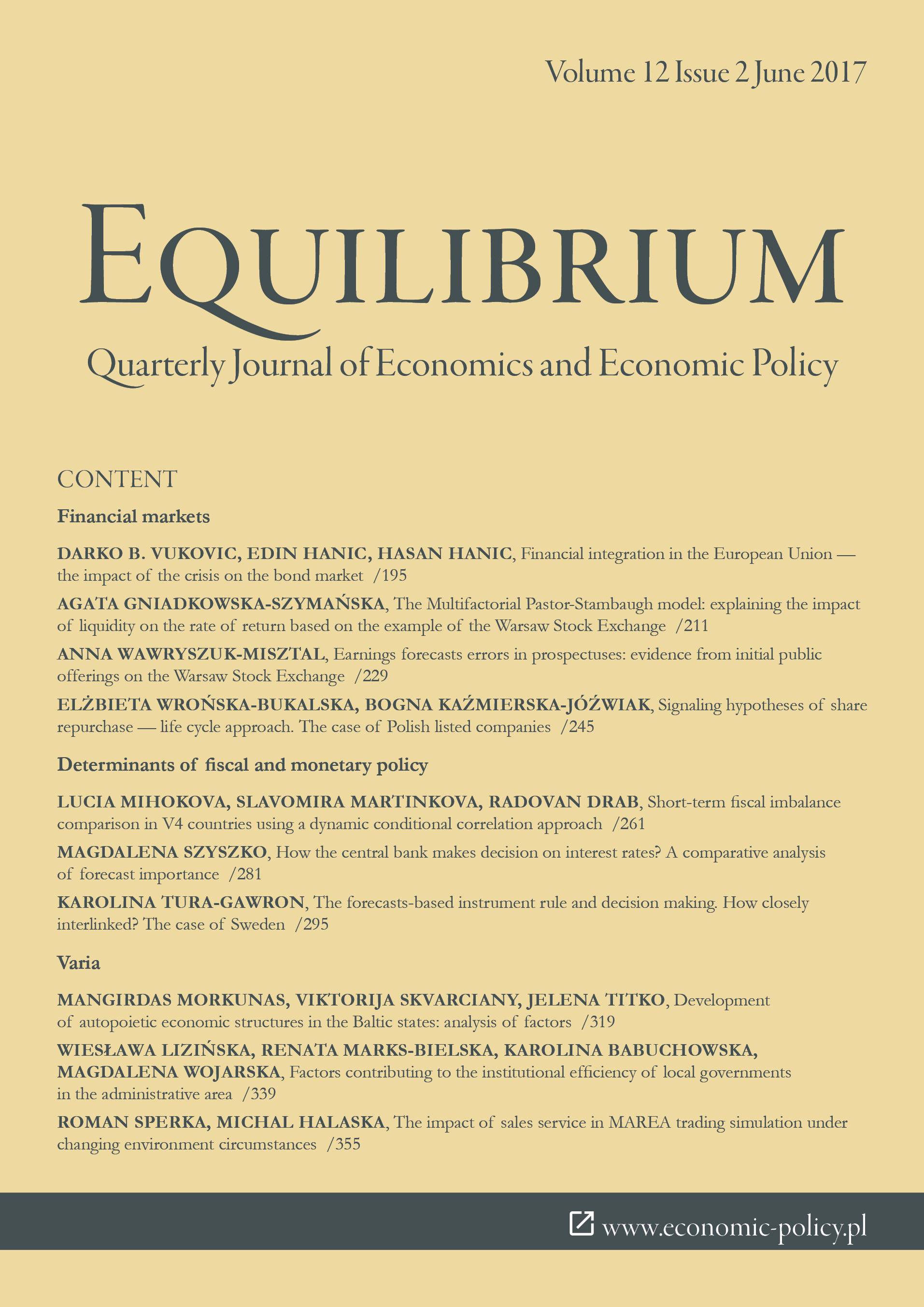Financial integration in the European Union - the impact of the crisis on the bond market
DOI:
https://doi.org/10.24136/eq.v12i2.10Keywords:
financial integration, crisis, bonds market, ALB model, European Monetary UnionAbstract
Research background: In our paper we have analyzed the influence of the crisis on the financial integration in the European Monetary Union. We have analyzed EMU capital market to show the impact of the crisis, with the focus on the bonds market. The determinants of the research are yields and standard deviations on medium-term and long-term triple-A bond markets, as well as CDS medium-term premiums.
Purpose of the article: The aim of this paper is to show the volatility of researched deter-minants in periods of crisis in EMU zones.
Methods: As a model we used a modified theoretical CAL portfolio model. In the last fifteen years Europe has been faced with two major crises: the world economic crisis and sovereign debt crisis.
Findings & Value added: We believe that the sovereign crisis hit EMU more, leaving the deeper implications on the financial integration. Our analysis has showed that the crisis had a major impact on the financial integration. Yields and standard deviations increased multiply in periods of crisis and left the impact of volatility on the capital market. However, the degree of convergence of euro area bond markets largely stabilized in last two years.
Downloads
References
European Central Bank (2016). Financial integration in Europe. doi: 10.2866/ 750198EU.
European Central Bank (2017). Retrieved form http://sdw.ecb.europa.eu/ (11.01.2017).
Fałdziński, M., Balcerzak, A. P., Meluzín, T., Pietrzak, M. B., & Zinecker, M. (2016). Cointegration of interdependencies among capital markets of chosen Visegrad countries and Germany. In A. Kocourek & M. Vavrousek (Eds.). 34th International conference Mathematical Methods in Economics MME 2016 Conference proceedings. Liberec: Technical University of Liberec. Retrieved form: http://econpapers.repec.org/bookchap/pesecchap/16.htm.
Grossman, E., & Leblond., P. (2011). European financial integration: finally the great leap forward? JCMS: Journal of Common Market Studies, 49(2). doi: 10.1111/j.1468-5965.2010.02145.x
Grubisic, Z., Zaric, S., & Vukovic, D. (2011). FDI inflow in see countries and its consequences in the context of the financial crisis. In D. Pavelkova. Finance and the performance of firms in science, education, and practice. Zlin: Tomas Bata University in Zlin.
Hu, K. (2015). Innovations of the European Central Bank in the context of financial and monetary integration: a Chinese assessment. Discussion Paper. Center for European Integration Studies, Rheinische Friedrich-Wilhelms Universität Bonn, C229.
Jovanovic, A., Vukovic, D., & Zakic, N. (2012). Allocation problems of institutional support for regional development financing in Serbia. Actual problems of economics, 138.
Lane, P. R. (2006). The real effects of EMU. IIIS Discussion Paper. IIIS, Trinity College Dublin and CEPR, 115.
Lane, P. R., & Milesi-Ferretti, G. M. (2007). The external wealth of nations mark II: revised and extended estimates of foreign assets and liabilities, 1970?2004. Journal of International Economics, 73(2). doi: 10.1016/j.jinteco.2007.02.003.
Grahl, J., & Teague, P. (2005). Problems of financial integration in the EU. Journal of European Public Policy, 12(6). doi: 10.1080/13501760500270679.
Guiso, L., Jappelli, T., Padula, M., & Pagano, M. (2004). Financial market integration and economic growth in the EU. Centre for studies in economics and finance. Dipartimento di scienze economiche ? Universit? degli studi di Salerno. Working paper, 118.
McCreevy, C. (2006). Europe has made real progress on financial integration. Financial Times, 8 December.
Pagano, M., & von Thadden, E. L. (2004). The European bond market under EMU. Oxford Review of Economic Policy, 20. doi: 10.1093/oxrep/grh031.
Pietrzak, M. B., Fałdziński, M., Balcerzak, A. P., Meluzín, T. & Zinecker, M. (2017). Short-term shocks and long-term relationships of interdependencies among Central European capital markets. Economics & Sociology, 10(1). doi: 10.14254/2071-789X.2016/10-1/5.
Praet, P. (2012). European financial integration in times of crisis. In The annual general meeting and conference 2012 of the International Capital Market Association (ICMA). 25 May 2012. Milan.
Vyklyuk, Y., Vukovic, D., & Jovanović, A (2013). Forex predicton with neural network: usd/eur currency pair. Actual problem of economics, 10(148).
Zinecker, M., Balcerzak, A. P., Fałdziński, M., Meluzín, T., & Pietrzak, M. B. (2016). Application of DCC-GARCH model for analysis of interrelations among capital markets of Poland, Czech Republic and Germany. In M. Reiff & P. Gezik (Eds.). Proceedings of the international scientific conference Quantitative Methods in Economics Multiple Criteria Decision Making XVIII. Vratna: Letra Interactive. Retrieved form: http://econpapers.repec.org/ bookchap/pesecchap/12.htm.






